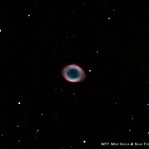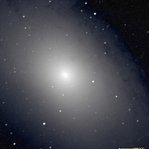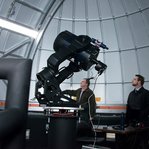Selden, NY - October 26, 2015 - Professor of Astrophysics Dr. Michael Inglis and Sean Tvelia, associate professor of physical science recently captured two stunning, out-of-this-world images -- a photo of the Moon, another of the Ring Nebula that is some 2,300 light years away and the Andromeda Galaxy -- from Suffolk County Community College's state-of-the-art observatory. A light year is equivalent to the distance that light travels in one year, which is nearly six trillion miles (that's a six with 12 zeros)!
The College's Observatory sits atop the Smithtown Sciences Building on the Ammerman Campus in Selden and is housed under a 20 ½ foot rotating dome. The observatory is equipped with networked computer controls allowing partial operation from remote locations. Full networking and remote operation are planned in the near future. Suffolk County Community College now has one of only five observatories in our county − Stony Brook University, Custer in Southold, The Vanderbilt Museum and Montauk are the other four – and Suffolk Community’s is among the largest.
The instrument can also be operated via electronic hand controls and is equipped with software that accesses a catalog of coordinates for 145,000 celestial objects that make viewing and moving from one object to another easier. The telescope’s primary mirror also has ultra-high transmission coatings to help increase light transmission by 20 percent, making objects brighter, and is mounted to a 12-foot-tall cylindrical metal pier that is filled with sand to dampen vibrations. There is an additional vibration dampening system on top of the pier that was designed and installed by Suffolk County Community College Science Department faculty, consisting of metal plates with rubber spacers.
Astronomers using the new telescope can also record what they are seeing through the college’s CCD Camera equipped with filters that meet astronomical research standards.
Pictured in Feature Image: Associate Professor of Astronomy Matthew Pappas, at right, and Associate Professor Gerald Schnal watch as the Suffolk County Community College Observatory doors open to the heavens. Associate Professor Schnal worked tirelessly to perfect the remote operational capabilities of the observatory.
Gallery Image 1: The Moon. Mare Humorum, with the crater Gassendi at its southern border.
Gallery Image 2: Nebula Messier 57, or the “Ring Nebula”, as it is more commonly known, that lies at a distance of 2,300 light years. This 100 second exposure was taken through red, green, blue and luminance filters, using a 300mm aperture telescope.
Gallery Image 3: Inner region of the Andromeda Galaxy, at a distance of 2.54 million light years.
Gallery Image 4: The Suffolk County Community College Observatory sits atop the Smithtown Sciences Building on the College's Ammerman Campus in Selden.















